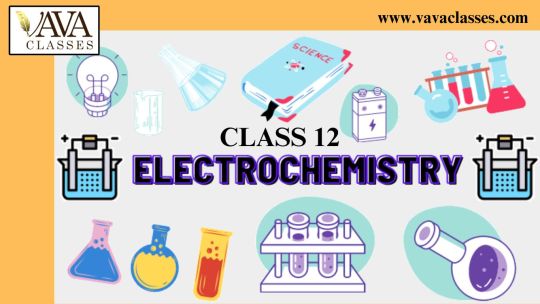#MOLAR CONDUCTANCE & EQUIVALENT CONDUCTANCE
Explore tagged Tumblr posts
Text
Electrochemistry Notes for Class 12 JEE and JEE Advanced
Introduction to Electrochemistry Class 12 Chemistry
Electrochemistry is the branch of chemistry that deals with the relationship between electrical energy and chemical changes. It primarily involves redox reactions, where oxidation and reduction occur simultaneously. Here are the key concepts and principles of electrochemistry for Class 12 and JEE preparation:

1. Electrochemical Cells
Galvanic (Voltaic) Cells: Convert chemical energy into electrical energy.
Consists of two half-cells connected by a salt bridge.
Anode (oxidation): Zn → Zn²⁺ + 2e⁻
Cathode (reduction): Cu²⁺ + 2e⁻ → Cu
Electrolytic Cells: Use electrical energy to drive non-spontaneous chemical reactions.
3. Electrode Potential
Standard Electrode Potential (E°): Measured under standard conditions (298K, 1M, 1 atm).
Nernst Equation: Used to calculate the cell potential under non-standard conditions.
Ecell =E°cathode−E°anode
Cell Potential (Ecell): Difference in potential between the cathode and anode.
Ecell = E°cathode - E°anode
4. Gibbs Free Energy and Cell Potential ΔG = -nFEcell If Ecell > 0, the reaction is spontaneous ΔG < 0. If Ecell< 0, the reaction is non-spontaneous ΔG > 0.
5. Electrochemical Series A list of standard electrode potentials. Metals with higher reduction potential are good oxidizing agents. Metals with lower reduction potential are good reducing agents.
6. Conductance of Electrolytic Solutions Conductivity (κ): Measure of the solution’s ability to conduct electricity. κ=1/ρ Molar Conductivity (Λm): Conductivity per unit concentration.
Λm= κ/c Variation of conductivity with concentration: Increases with dilution for strong electrolytes. Initially increases then decreases for weak electrolytes.
7. Kohlrausch's Law of Independent Migration of Ions The limiting molar conductivity of an electrolyte can be represented as the sum of the individual contributions of the anion and cation.
Λm°= λ+° + λ−° 8. Electrolysis Faraday’s Laws of Electrolysis: First Law: The mass of the substance deposited or liberated is directly proportional to the quantity of electricity passed. m=Z⋅Q
Second Law: The masses of different substances deposited or liberated by the same quantity of electricity are proportional to their equivalent weights.
9. Batteries and Fuel Cells Primary Batteries: Non-rechargeable (e.g., dry cell, mercury cell).
Secondary Batteries: Rechargeable (e.g., lead-acid battery, nickel-cadmium battery).
Fuel Cells: Convert chemical energy directly into electrical energy (e.g., hydrogen-oxygen fuel cell).
10. Corrosion Electrochemical process where metals are oxidized in the presence of air and moisture.
Prevention methods: Coating (painting, galvanizing). Using sacrificial anodes. Applying corrosion inhibitors.
Recommended Books and Resources 1.
NCERT Chemistry Class 12 Textbook
2. O.P. Tandon – Physical Chemistry
3. P. Bahadur – Numerical Chemistry
4. JEE Main and Advanced previous years' question papers
0 notes
Text
Gas Constant
One of the fundamental states of matter is the gaseous state, commonly known as gas. Gases possess distinct characteristics that set them apart from other states of matter. Despite being highly compressible, gases evenly distribute pressure on all sides. They lack a definite shape and volume, instead adapting to the shape of the container they occupy. Moreover, gases readily mix due to minimal interactions between their intermolecular forces.
The behavior of gases is governed by several sets of laws derived from experimental studies conducted under various conditions, including temperature, pressure, and volume. This discussion centers around a specific constant known as the gas constant (R) and its significance.
The gas constant (R) is a physical constant expressed in units of energy per temperature increase per mole. It is also referred to as the molar gas constant or universal gas constant. The value of R is equivalent to that of the Boltzmann constant, although the latter is expressed in terms of the pressure-volume product. This constant plays a crucial role in understanding the behavior of gases and their properties under different circumstances.
Ideal Gas
An ideal gas is a theoretical concept used in physics and chemistry to simplify the behavior of gases under certain conditions. It is a hypothetical model of a gas that follows specific ideal gas laws, making its behavior easy to analyze and calculate.
The behavior of real gases deviates from the ideal gas model at high pressures and low temperatures, where intermolecular forces become significant, and the volume of gas particles becomes non-negligible. However, real gases behave similarly to ideal gases under many conditions, especially at low pressures and high temperatures.
An ideal gas can be defined as the theoretical representation of a gas comprising point particles that do not reveal any alterations during intermolecular movements. The ideal gas follows all three fundamental laws as given by Charles, Avogadro, Boyle, and Gay Lussac.
V ∝ 1/P with T and n as constant (From Boyle's law)
V ∝ T with P and n as constant (From Charles law)
Finally, V ∝ n with T and n as constant (From Avogadro's law)
Combining all three of these gives V ∝ n X T/P
Mathematically, this can be expressed as,
PV = nRT
Here,
P is the pressure
V is the volume
T is the temperature
R is the Ideal Gas Constant, and
n is the amount of substance
Gas Constant Laws
The gas constant r is a vital factor for numerous principles and laws of physics. It is used in various laws as a combination of a constant and equations as a fundamental factor.
Boyle's Law: Boyle's Law is a fundamental gas law that describes the relationship between the pressure and volume of a gas at a constant temperature. It states that when the volume of a gas decreases, its pressure increases, and vice versa, as long as the temperature remains constant. In mathematical terms, Boyle's Law can be expressed as:
P ∝ 1/V
where P is the pressure of the gas, and V is its volume. The law implies that the product of the pressure and volume of a given amount of gas is constant, provided the temperature remains unchanged.
Charles's Law: Charles's Law, also known as the law of volumes, relates the volume of a gas to its temperature at constant pressure. It states that the volume of a gas will increase or decrease in direct proportion to its absolute temperature as long as the pressure remains constant. In mathematical terms, Charles's Law can be represented as:
V ∝ T
where V is the volume of the gas, and T is its absolute temperature (measured in Kelvin). As the temperature of a gas rises, its volume will expand, and conversely, as the temperature decreases, the volume will contract.
Avogadro's Law: Avogadro's Law states that under the same temperature and pressure conditions, equal volumes of different gases contain an equal number of molecules. This law is based on the idea that the volume of a gas is directly proportional to the number of molecules it contains. In mathematical terms, Avogadro's Law can be expressed as:
V ∝ n
where V is the volume of the gas, and n is the number of gas molecules. It implies that at constant temperature and pressure, the number of molecules to the volume ratio is constant for all gases.
Gay-Lussac's Law: Gay-Lussac's Law, also known as the pressure-temperature law, describes the relationship between the pressure and temperature of a gas at constant volume. It states that the pressure of a fixed amount of gas is directly proportional to its absolute temperature, provided the volume remains constant. Mathematically, Gay-Lussac's Law can be represented as:
P ∝ T
where P is the pressure of the gas, and T is its absolute temperature. This law implies that if the temperature of a gas increases, its pressure will also increase, and if the temperature decreases, the pressure will decrease, assuming the volume remains constant.
0 notes
Text
@bowtiepastabitch you are always allowed to ask why!

to speed run concentration measurements, a really common on used in chemistry is molarity (M). morality is moles of solute per liter of solution.
so if you have like 1 molar NaCl, that means there is one mole of sodium chloride in a total of 1 liter of solution.
(the mole is an arbitrary unit of measurement that we use A lot. one mole is 6.022 x 10^23 things, in this case ions or acid molecules)
also to do a little speed run, strong vs weak acids. there are 6 strong acids, hydrochloric (HCl) being one of them. every other acid is considered "weak". this does not mean they aren't dangerous. the difference between strong and weak acids is how much they dissociate in water. so, strong acids will dissociate almost completely (ie a Hydrogen will pop off of nearly every molecule) whereas weak acids will only partially dissociate.
we use acids for all sorts of things in lab. we used hydrochloric quite a bit last quarter during the thermodynamics chapter because you can react certain metals in it and measure the amount of heat released by the process.
but this quarter has so far been largely about equilibriums and acid/base reactions.
last week's lab consisted of 4 smaller experiments that all had to do with achieving equilibrium and we achieved this by mixing various different acids and bases. for one such experiment we used 12 M HCl which is very strong, so strong that it can and will smoke when you pipet it into a test tube if your test tube has residual water in it. this experiment was basically just adding HCl to a hydrate and observing the change in color, and then adding water and observing the change in color. we did other ones with different concentrations of HCl where we used it to form precipitates in solution.
this week's lab was all about how acids and bases react with each other and observing changes in pH. we did this thing that you do sometimes in lab where you take a stronger stock solution, in our case 2M acetic acid, and you dilute a specified amount of it to reach your desired molarity. we did this a couple times to observe changes in pH in different concentrations of the same acid.
we also did a titration of a strong base (NaOH) into a strong acid (HCl) so that we could graph a titration curve and observe when the equivalence point (neutralization point basically) is reached.
acids have a lot of uses in lab. they're especially useful when you're first really learning about how they work and you want to observe how pH is not dependent on the type of acid but rather how much acid you have in relation to water. strong acids are also electrolytes so you can use them to conduct electricity if you want to (we did way back in the fall)
as for what i actually do all day, it really is a lot of math. and the lab is followed by even more math and also an attempt at writing words that make sense (lab reports).
nothing like telling my parents about what i did in lab today and my mom being like "oh cool (i don't know what that means but slay)" while my dad is like "isn't 2M acetic acid like. REALLY strong" and then i'm like "DAD WE USED 12M HYDROCHLORIC LAST WEEK THIS IS NOTHING" and then my mom is like "should i be concerned for your safety?"
9 notes
·
View notes